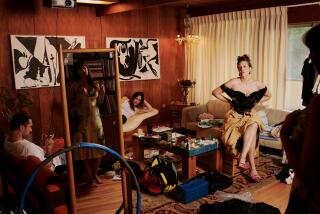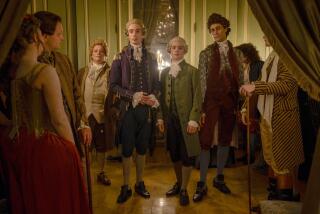‘Downton Abbey’ cast costumes on exhibit at Delaware’s Winterthur
When another day dawns at Downton Abbey, the efficient Mrs. Hughes is already attired in her black-on-black patterned dress. But who knew that Mrs. Hughes was so chic?
A television screen flattens colors so it’s impossible for viewers to see, much less appreciate, the beading and applique on her dress. No sensible woman of any era would wear it to do real housework or run up and down a Yorkshire castle’s staircases.
This costume, plus 39 others worn on PBS’ “Downton Abbey,” is on exhibit through Jan. 4 at Winterthur, a former du Pont estate in the Brandywine River Valley, just across the border from Pennsylvania’s Chester County.
“We have costumes from every single season,” said Maggie Lidz, one of four people who curated the show.
Winterthur (pronounced Winter-TUR) was the home of Henry Francis du Pont and his wife, Ruth Wales. The 982-acre compound, which opened to the public in 1951, has 60 acres of gardens plus 175 room displays that span American decorative arts from 1640 to 1860. Although the mansion is now undergoing a major renovation, it remains open for tours.
Inside the Galleries Building, this beautifully lit costume exhibition has broken all attendance records at the estate, topping its usual 110,000 annual attendance already. After a gala party March 1, the crowds poured in, hungry for haute couture, tiaras and tea. By mid-September, 125,000 people had visited Winterthur, said Liz Farrell, a museum spokeswoman.
Lidz, a social historian, traveled to London in June 2013 and visited Cosprop, a leading international supplier of costumes for film, television and theater.
“I had a shopping list and a budget for 35 costumes. I came back with 40,” she said, adding that Cosprop “was so different than a museum. It’s kind of like a big, messy dry-cleaning shop. Things are going in and out very quickly. They are thinking of their next movie production.”
The “Downton Abbey” costumes, she said, are “an entrance point into early 20th century history, a rich time period when the United States became central to world politics and world finance. The financial center of the world shifted from London to New York. I hope people become more interested in this period,” Lidz said.
In this particular era, she noted, the Brits liked American heiresses, films and jazz while Americans favored British accents, gin and fine Savile Row tailoring.
These are evocative, sumptuous clothes. There’s a sea green velvet dress plus a stunning blue-and-gold harem outfit, both of which were worn by Lady Sybil.
Lady Mary’s black-and-white spider gown radiates a kind of glamour we associate with the likes of Marlene Dietrich or Greta Garbo, and it is displayed under a glittering crystal chandelier loaned especially for this show. The burgundy gown she wore when Matthew proposed to her is near a video clip of that climactic moment.
Countess Cora’s mauve dress and matching hat, worn during a mourning period, exemplify the shades of lavender, gray, lilac and mauve that dominated England during the 1890s, so much so that fashion historians called it the Mauve Decade.
Lady Edith’s exquisite, sparkling wedding gown will, no doubt, inspire variations among young American brides. (Or perhaps not, given how that episode ended.) The gown’s train is vintage, and the dress was designed to match it.
You will see the household help’s wardrobe, too, including Mrs. Patmore’s kitchen outfit and Daisy’s simple dress. Note that the buttons on the coat worn by Thomas, the under butler, bear the Grantham family crest.
Visitors also learn how the du Ponts’ lifestyle differed from that of the fictional Crawleys. Lidz is an expert on this topic because she is writing a book about service spaces in American homes, which included butler’s pantries, closets, kitchens, laundries, nurseries, garages and wine cellars. One way the countries differed was how they called the servants.
“By the early 1900s, an American house would never have had a pull system (of bells). We had push buttons,” Lidz said. “The British don’t have the elevators, the telephones, the electric bell systems. The British thought it was status-lowering.”
Not surprisingly, the du Ponts dressed and traveled stylishly. Mrs. du Pont’s traveling case, custom-made in London, is a symphony of craftsmanship in crocodile leather that weighed 17 pounds when it was empty. It held crystal bottles, lipstick, stationery, an oil can and a hair crimper, forerunner of the curling iron.
A black wool blazer tailored for Henry Francis du Pont on Savile Row in London is on exhibit next to his enormous traveling trunk. Luggage like that required full-time servants to lug it around.
During the early 1900s and even today, men who are confirmed fashionistas may own a vicuna coat or jacket. A jacket can run you $22,000 today while a suit would cost as much as $40,000, custom-made, of course.
“You can’t get it retail. You don’t fondle it at the local mall,” Lidz said, adding that vicuna is the most expensive fabric in the world.
But at this show, you can touch a cinnamon brown sample of vicuna along with some sheep’s wool. The difference in softness is immediately palpable. A valet like Mr. Bates would know it instantly, of course.
“The world of Downton Abbey is a coded world,” Lidz said. “You have to know that particular color of brown, that that coat is different. It’s what a lot of the blogs are about: Who is dressed this way and why?”
White summer fashions include a cable sweater Matthew Brady wore in a cricket match and Lady Mary’s white day suit and matching hat, so timeless it would work well for a professional woman today.
Most costumes are displayed on Ethafoam mannequins. Each garment was fitted to the actor or actress who wore it so it’s also a reflection of his or her figure. Kathleen Kiefer, a textile conservator and graduate of Winterthur’s program, led a team of conservators who made the mannequins, which account for the lion’s share of the show’s cost.
“Every single mannequin had to be hand cut to fit the costumes so the costumes could be supported,” Lidz said.
(c)2014 Pittsburgh Post-Gazette
Visit the Pittsburgh Post-Gazette at https://www.post-gazette.com
Distributed by MCT Information Services
PHOTOS (from MCT Photo Service, 312-222-4194): UST-DOWNTON-ABBEY
More to Read
Sign up for The Wild
We’ll help you find the best places to hike, bike and run, as well as the perfect silent spots for meditation and yoga.
You may occasionally receive promotional content from the Los Angeles Times.






